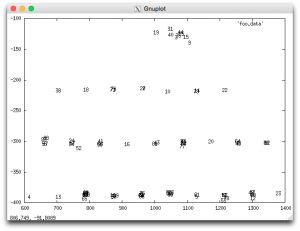The problem’s introduction reads:
Monty Hall wrote a script of how he was supposed to run one of his game shows for his trusty accounting computer some time ago, but hes not really sure what the punch cards mean any more. I mean, that was a while ago. Only, hes sure his key is hidden somewhere in these punch-cards, if he could figure out how to run them… : 150
and they provide a tarball of PNG files that appear to be punch cards.
You could translate these manually, but a bunch of people have implemented their own punch card readers, and I found a nice python script that might read the images. However, it seems to want them in inverted colors (white holes, not dark). I inverted them with Gimp (color->invert) and then ran the script. The script seemed to work well, but it missed the first column in my case. Note that you can use the “-i” and “-d” options to the script to help your debugging efforts. There’s probably some way to adjust the script to catch the first column, I didn’t bother to look into that.
Running the script across all the cards in numerical order yields this text:
DENTIFICATION DIVISION. PROGRAM-ID. LETS-MAKE-A-DEAL. AUT HOR MONTE HALPARIN. ATA DIVISION. WORKING-STORAGE SECTION. 01 DOORCHOICES. 02 GOODDOOR PIC 9. 02 FIRSTCHOICE PIC 9. 02 OPENDOOR PIC 9. 02 C NGEDOOR PIC 9. 01 CURRENTDATE. 02 CURRENTYEAR PIC 9(4). 0 CURRENTMONTH PIC 99. 02 CURRENTDAY PIC 99. 01 DAYOFYEAR. 02 CURRENTMONTH FILLER PIC 9(4). 02 YEARDAY PIC 9(3). 01 URRENTTIME. 02 CURRENTHOUR PIC 99. 02 CUR RENTMINUTE PIC 99. 02 CURRENTTENS PIC 9. 02 CURRENTONES PIC 9. 02 FILLER PIC 99. PROCEDURE DIVISION. DISPLAY 'MH: WELCOME TO L ETS MAKE A DEAL'. D PLAY 'MH: THERE ARE THREE DOORS. ONLY ONE WITH THE KEY' . ACCEPT CURRENTTIME OM TIME. IF CURRENTONES < 4 SET GOODDOOR TO 1 ELSE IF CURRENTONES < 7 SET GOODDOOR TO 2 ELSE SET GOODDOOR TO 3 END-IF END-IF DISPL 'MH: YOU MAY ONLY OPEN ONE DOOR. WHICH DOOR?'. IF CURR ENTTENS = 0 OR CURR TTENS = 3 SET FIRSTCHOICE TO 1. IF CURRENTTENS = 1 O R CURRENTTENS = 4 T FIRSTCHOICE TO 2. IF CURRENTTENS = 2 OR CURRENTTENS = 5 SET FIRSTCHOICE O 3. DISPLAY 'PLAYER: I PICK DOOR ' FIRSTCHOICE '.' IF FIRSTCHOICE = GOODD R DISPLAY 'MH: THAT IS AN INTERESTING CHOICE OF DOOR .' IF CURRENTTENS R 0 OR CURRENTTENS = 4 SET OPENDOOR TO 3 END-I F IF CURRENTTENS = OR CURRENTTENS = 5 SET OPENDOOR TO 1 END-IF IF CURRENTTENS = 2 OR CURRENTTENS = 3 SET OPENDOOR TO 2 END-IF DISPLAY 'MH: LET GIVE YOU A HINT.' DISPLAY 'MONTY HALL OPENS DOOR ' OPENDOOR DISPLAY ' GOAT RUSHES OUT WITH NO KEY.' DISPLAY 'MH: WOULD YOU LIKE TO CHANGE YOUR GOOR CHOICE?' DISPLAY 'PLAYER: YES! MY LOGIC MINOR I N COLLEGE HAS A USE!' GOOR IF CURRENTTENS = 2 OR CURRENTTENS = 4 SET CHANGEDOOR TO 1 D-IF IF CURRENTTENS = 0 OR CURRENTTENS = 5 SET CHANGEDOOR TO 2 E -IF IF CURRENTTENS = 1 OR CURRENTTENS = 3 SET CHANGEDOOR TO 3 EN IF DISPLAY 'PLAYER: I WILL CHOOSE DOOR ' CHANGEDOOR ' INSTEAD!' ELSE ET CHANGEDOOR TO FIRSTCHOICE. IF CHANGEDOOR = GOODDOOR DISPLAY 'MH: CONGR ETULATIONS! YOU FOUND A KEY.' DISPLAY 'MH: THE KEY I S:' DISPLAY 'KEY ETALEXTREBEKISASOCIALENGINEER)' ELSE DISPLAY 'MONTY HA LL OPENS THE DOOR. GOAT JUMPS OUT.' DISPLAY 'MH: THIS IS THE INCORRECT DOOR.' DISPLAY 'TH GOAT EATS YOUR PUNCH CARDS. START OVER.'. STOP RUN.
That’s (broken) Cobol, yuck, but it looks like we got most of the content. All that remains is to find the key and fill in any missing details. If you read through the code, you’ll see line 29/30 talks about the key. Looks like “KEY ETALEXTREBEKISASOCIALENGINEER)” but its missing the first character of one of the lines. No worries, you can fill it in manually using a conversion chart.
My by-hand conversion of those two cards has the key as “(SETALEXTREBEKISASOCIALENGINEER)” but that doesn’t seem to work as an answer.
Chris tried ALEXTREBEKISASOCIALENGINEER, which is indeed the key.
This started a trend of me almost finishing problems and other people figuring out what the correct key for the problem was.
That’s why you work in a team, right?


